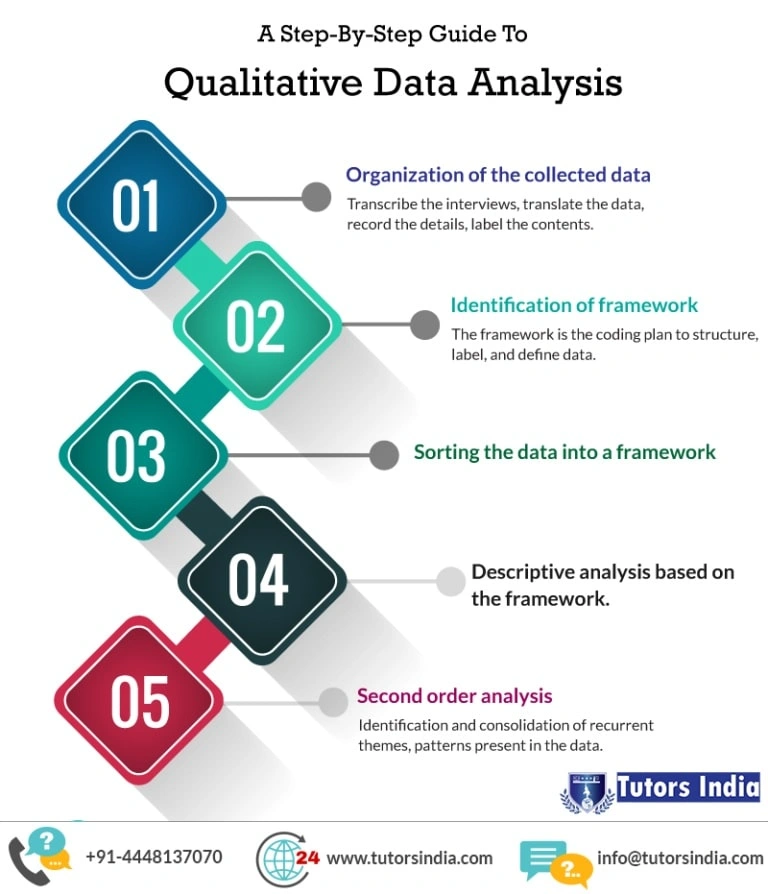What Is A Qualitative Data Analysis And What Are The Steps Involved In It?
Qualitative Study
Qualitative study is about formulation of concepts that explains a social phenomenon in its settings, giving due importance to the experience and views of the participants. It is a study on subjectivity to identify or explain a happening.
- In order to do a genuine research that results in a proper study, the researcher must- understand the context of how various factors like economic, political, social, cultural, etc., influence a subjective account.
- Understand the participants, how each experience things their own way.
- Understand the process of data collection where the setting and interaction plays a part in how people respond.
Qualitative Data
Qualitative data are collected via interviews, stories, writings, comments, observations, focus groups, audio, video, etc. The data collection process of a qualitative research is more of an organic process, i.e., open-ended and less structured. The participants are not restricted and responses are recorded in natural settings to get a legitimate account of what they feel or experience. Researcher has to be responsive and attentive and pay attention to details.
Sample Size In Qualitative Research is dependent on the nature of the study. In general, as much data are collected from different participants until the responses become predictable.
Qualitative Data Analysis (QDA)
Data Analysis For Qualitative Research is the process of making sense of the collected data; identifying patterns and concepts to explain, understand or interpret a phenomenon, situation or a people that is being investigated. It is the interpretation and examination of meaningful and symbolic data.
In general, there are two approaches to Qualitative Data Analysis:
Deductive Approach is used when qualitative study is a small part of a larger quantitative research. It involves using research question to look for differences and similarities.
Inductive Approach is used for Qualitative studies or when it is the major component. This approach involves using emergent framework to group data and identifies patterns and concepts.

Steps Involved In Qualitative Data Analysis:
Owing to the nature of the data, structured or unstructured, QDA is a non-linear process and requires a preliminary analysis. These are the steps involved in a qualitative data analysis:
Organize The Collected Data
In order to organize the researcher needs to transcribe the interviews, translate the data, record the details, and label the contents.
Identification Of Framework forms the next step
This requires intense reading to understand the data. As it progresses researcher needs to identify a framework, either based on the explanation of the research question or the exploration of data. The framework is the coding plan to structure, label, and define data.
Sorting The Data Into A Framework comes next
This step necessitates sorting data into a framework.
Descriptive Analysis based on the framework is the next step
The framework should provide insights into the range of responses and recurring themes from the data. Identifying this pattern will be the end product in case of an exploratory research.
Second Order Analysis is the final step of the QDA
This step involves identification and consolidation of recurrent themes, patterns present in the data, and respondent clusters; building sequence of the events to facilitate an answer for the research question, in order, to develop a hypothesis that can be tested.
The above steps are common or similar for all types of qualitative analysis. In general, there are five types of qualitative analysis:
Content Analysis
Categorizing verbal and behavioral data, based on description and interpretation.
Narrative Analysis
Analyzing and revising narrated contents provided by different participants from different backgrounds and experiences.
Discourse Analysis
Analyzing naturally occurring discourses and discussions of participants to rationalize their daily life with attention to the context and setting.
Framework Analysis
This involves familiarizing, identifying a thematic structure, coding, charting, and mapping and interpreting.
Grounded Theory
This analysis involves formulation of a statement with each sample studied and carrying on until a common statement about a population emerges.
Use Of Software For QDA:
Manually carrying out a qualitative data analysis is tedious and time consuming process. Use of software can help ease this burden and speed up the whole task. Computers can be used to transcribe, write, edit, store, code, search and retrieve data, in addition to graphic mapping, identifying patterns, and reports.
Some of the frequently used software for qualitative data analysis are: Atlas TI, Hyper Research, Max QDA, QSR Nvivo, Weft QDA etc.
Links, References, Related Posts
– Choosing The Right Data Collection Methods For A Successful Thesis
– Why Tutors India for Econometric and Financial Statistical Analysis Support Services
– The Importance Of Having Biostatisticians On Every Clinical Research
– Why Tutors India for Statistical Support Services
– Our Statistics Mentors – Meta-Analysis: A Quantitative Approach To Research Integration
